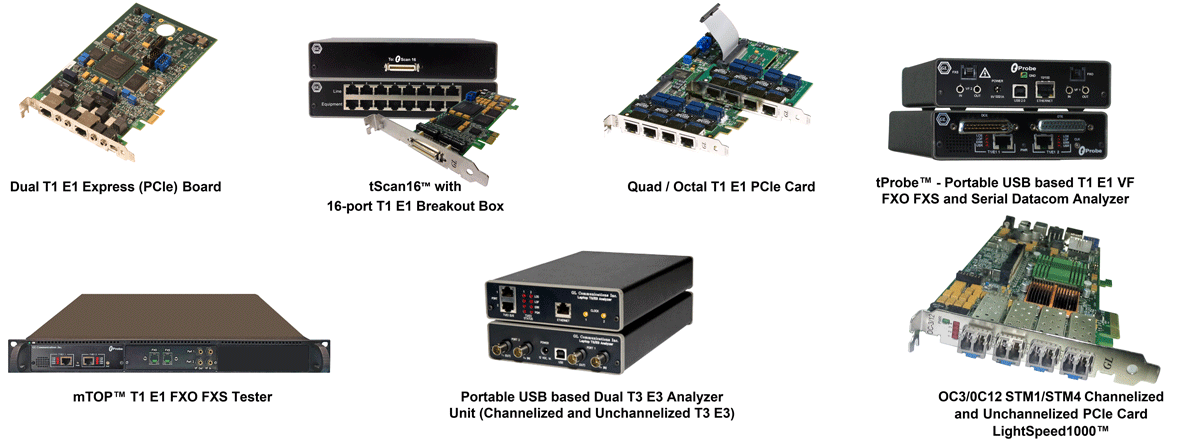GL Enhances T1 E1 Emulation / Analyzer Products and Software
Welcome to another issue of GL's Newsletter covering new applications and enhancements for our versatile T1 E1 analyzer product line.

Overview
GL’s T1 E1 analyzer is a powerful, fully-featured BERT, voiceband, data, signaling, and protocol analysis tool. The analyzer can perform analysis and emulation of various signal types including voice, digits, and tones; and various protocols including HDLC, ISDN, SS7, CAS, Frame Relay, GSM, GPRS, CDMA, and UMTS. It is capable of T1 or E1 PCM signal visualization, capture, storage, analysis, and emulation.
In addition, convenient features are available like portable, USB-friendly interface to a PC, single or dual multiport repeaters, and scripting. T1 E1 analyzer is also available in mTOP™ rack enclosures with USB-based units which can be stacked to provide a high-density form factor solution.
Recent Enhancements
- Support for Unframed mode in "Frame Relay Emulator" has been added where user can include Timeslot 0 for transmission/reception
- AIN, CAMEL, MAP, ANSI TCAP, and CNAM protocols are supported over the ATM layer in MAPS
- Enhanced T1 E1 BERT commands to give error insertion rate and bit inversion capability
- Protocol Analyzers:
- Added protocol decode errors and data link errors for searching and filtering criteria
- Implemented aggregate column priority groups for protocol analyzers
- User can now aggregate column items user interface for reversing order src->dst or dst->src and rearrange it in any order using GUI
- Packet Data Analysis (PDA) has been introduced for offline protocol analyzers – CAS, SS7, ISDN, and GSM
- MAPS™ CLI Update:
- Java Client DLL and Parser files have been updated to fix the floating number argument issue
- Updated CLI with Python client and parser files for 32/64-bit versions and Python version 2 and 3
- Support for decoding UK caller ID
- MFR-IP-PacketCheck™:
- Bandwidth Configuration and Transmission Rate Control is now applicable to per stream instead of per virtual channel
- Selection of Packet Mode for each stream is provided based on the default values that are selected and loaded to the respective configuration fields. Customization of those configuration values is also provided
- Supported Packet Mode selection options are FR-Route, FR-Bridge, FR-Q.933, PPP-IPV4, PPP-LCP, and Custom
- Transmit and Receive option now supports for Non-MFR Frames
- Default flags between frames have been changed from 100 to 1
- Datacom Analyzer:
- Included WCS scripts for Datacomm interface and enhanced BERT WCS script for Datacomm, T1, and E1 analyzer
- MAPS™ APS:
- The VBM synchronization mechanism uses single-frequency tones instead of DTMF
- Debug option has been included to show on/off time for detected call progress tones and to record call setup
- The MAPS™ APS support for E and M Protocol
- The voice band measurements reports can be sent to a central database (NetSurveyorWeb™)
- The scripts are updated to support ground-start signaling
- MAPS™ CAS:
- CAS now supports SS5, SF signaling, voice call signaling simulation for E1
- Windows Client Server (WCS):
- British Telecom extension has been added to Caller-ID module
- Python client enables native Python programming using WCS commands, tasks, and structured Python-style responses
- MAPS™ FXO FXS:
- Added support for pulse dialing
- MAPS™ ISDN:
- The ISDN scripts are updated with ARINC standard support
 Back to Newsletter Index Page
Back to Newsletter Index Page